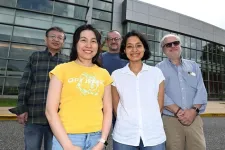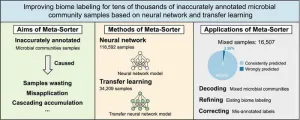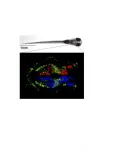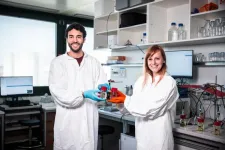(Press-News.org) Metastasis is the leading cause of death in cancer, occurring when a cell leaves the primary tumour, passes into the bloodstream and lymphatic system and reaches distant organs. Non-invasive collection of these circulating tumour cells is essential for the study of cell biology, the diagnosis and prognosis in cancer research, and drug development. As a general rule, the concentration of cancer cells found in blood is very small with respect to other cell types, and traditional methods of collecting them in a viable way are laborious.
“We wanted to come up with a device capable of concentrating cancer cells in order to detect their concentration,” explained Janire Sáez, Ikerbasque research professor in the UPV/EHU’s Microfluidics Cluster Group. The biosensors (devices for measuring biological or chemical parameters containing a component of a biological nature) developed so far for this purpose damage cells during the capture and release processes, and so the Microfluidics Cluster group has combined smart materials with the area of bioelectronics (which is about applying carbon-based semiconductors) so that the capture and release of cancer cells can be measured.
The procedure has been detailed in a chapter of the book Microfluidic Systems for Cancer Diagnosis, geared towards the scientific community and which explores the latest advances in microfluidic technologies for cancer diagnosis and monitoring. The book is an ideal guide to the laboratory construction of microfluidic devices specifically developed for cancer diagnostics and to promoting the development of new and improved diagnostic devices. As the Ikerbasque research professor explained, “we show a bioelectronic device consisting of microfabricated gold electrodes coated with a smart polymer (which reacts to temperature changes) and which enables the non-invasive capture and release of circulating tumour cells to be made, and the simultaneous electrical and optical monitoring of the entire process to be conducted”.
First steps towards a major breakthrough
“Our tests were performed in culture media; we did not use actual patient samples, but commercial cells sustained in cell culture. We confirmed that our device enabled us to capture and release the cells,” explained the researcher. Now, they are working to tailor the polymer specifically to different cell types. The device “is the outcome of collaboration with a group at the University of Cambridge, with whom we continue to collaborate, and where the device is currently being applied to samples from oesophageal cancer patients. Through this device, cancer cells are being selectively reconcentrated in order to detect their concentration”, said Sáez.
The researcher pointed out that these are “the first steps towards developing platforms for cancer screening. This could be a good step forward because they generally involve low-cost technologies and can be mass-produced. The idea is to use this type of technology for early cancer diagnosis”.
Right now, the Microfluidics Cluster group is focusing its studies on the development of “micrometric structures for bioelectronic devices of this type. We are also developing 3D systems to create 'organ-on-a-chip' systems (biomimetic systems that simulate organs in the human body)”, she concluded.
Additional information
The Ikerbasque research professor Janire Sáez lectures in the subject Tissue Engineering for Biochemistry and Biotechnology students.
END
Using smart bioelectronic devices to capture and release tumor cells
A group at the University of the Basque Country (UPV/EHU) is proposing the development of low-cost universal platforms for early cancer screening
2023-09-08
ELSE PRESS RELEASES FROM THIS DATE:
Obstetrics & Gynecology devotes special issue to addressing racism in reproductive health
2023-09-08
September 8, 2023 — As part of its active efforts to dismantle systemic racism and promote principles of equity and inclusion within its editorial processes and content, Obstetrics & Gynecology, the official journal of the American College of Obstetricians and Gynecologists, has devoted its entire October 2023 issue to addressing racism in reproductive health. The journal is published in the Lippincott portfolio by Wolters Kluwer.
A journal with such a rich history must root out inequity
"Let ...
Valleytronics is warming up at Brookhaven Lab
2023-09-08
UPTON, NY—Researchers at the Center for Functional Nanomaterials (CFN), a U.S. Department of Energy (DOE) Office of Science User Facility at DOE’s Brookhaven National Laboratory, and Northrop Grumman, a multinational aerospace and defense technology company, have found a way to maintain valley polarization at room temperature using novel materials and techniques. This discovery could lead to devices that store and process information in novel ways using this technology without the need to keep them at ultra-low temperatures. Their ...
Refining biome labeling for microbial community samples: AI approach unravels hidden
2023-09-08
In a groundbreaking study published on July 26, 2023, in the journal Environmental Science and Ecotechnology, researchers from Huazhong University of Science and Technology have introduced "Meta-Sorter," an AI-based method that leverages neural networks and transfer learning to significantly improve biome labeling for thousands of microbiome samples in the MGnify database, especially those with incomplete information. The Meta-Sorter approach comprises two crucial steps. Firstly, a neural network model is meticulously constructed using 118,592 microbial samples from 134 biomes and their respective biome ontology, boasting an impressive average ...
Exercise-induced hormone irisin may reduce Alzheimer’s disease plaque and tangle pathology in the brain
2023-09-08
BOSTON – Researchers who previously developed the first 3D human cell culture models of Alzheimer’s disease (AD) that displays two major hallmarks of the condition—the generation of amyloid beta deposits followed by tau tangles—have now used their model to investigate whether the exercise-induced muscle hormone irisin affects amyloid beta pathology.
As reported in the journal Neuron, the Massachusetts General Hospital (MGH)–led team has uncovered promising results suggesting that irisin-based ...
Immunogenicity and reactogenicity of co-administration of COVID-19 and influenza vaccines
2023-09-08
About The Study: In this study of health care workers who received a COVID-19 vaccine, an influenza vaccine, or both, co-administration was not associated with substantially inferior immune response or to more frequent adverse events compared with COVID-19 vaccine administration alone, supporting the co-administration of these vaccines.
Authors: Gili Regev-Yochay, M.D., of the Sheba Medical Center in Ramat Gan, Israel, is the corresponding author.
To access the embargoed study: Visit our For The Media website at this link https://media.jamanetwork.com/
(doi:10.1001/jamanetworkopen.2023.32813)
Editor’s ...
Readmission rates after acute respiratory distress syndrome in children
2023-09-08
About The Study: The findings of this study suggest that childhood survivors of acute respiratory distress syndrome (ARDS) are at high risk of readmission in the first two months after discharge. Future studies should evaluate whether post-discharge interventions (e.g., telephonic contact, follow-up clinics, and home health care) may help reduce the readmission burden.
Authors: Garrett Keim, M.D., of Children’s Hospital of Philadelphia, is the corresponding author.
To access the embargoed study: Visit our For The Media website at this link https://media.jamanetwork.com/
(doi:10.1001/jamanetworkopen.2023.30774)
Editor’s ...
Ballet of the brain: Unlocking the choreography of movement
2023-09-08
The zebrafish brain, though simpler than its human counterpart, is a complex network of neurons that engage in a ceaseless dance of electrical activity. What if this neural ballet could reveal the secrets of how brains, including our own, control movement? A zebrafish study led by researchers at the Champalimaud Foundation offers a new lens through which to view the activity of neural populations, and to understand how the brain orchestrates motion.
Why we have a brain
“The brain’s primary function is movement”, explains Claudia Feierstein, lead author of the study ...
Bacteria generate electricity from wastewater
2023-09-08
“We engineered E. coli bacteria, the most widely studied microbe, to generate electricity,” says Professor Ardemis Boghossian at EPFL. “Though there are exotic microbes that naturally produce electricity, they can only do so in the presence of specific chemicals. E. coli can grow on a wide range of sources, which allowed us to produce electricity in a wide range of environments, including from waste water.”
In a paper published in the journal Joule, Boghossian’s team report a groundbreaking achievement in bioelectronics, advancing the capabilities of common E. coli bacteria to generate ...
Probing the unimaginable: New data help to understand the nature of aphantasia
2023-09-08
The ability to visualize faces, objects, landscapes, or even scenes from the past exists on a spectrum. While some can picture the layout of a city in minute detail and mentally walk through it, street by street, others have a perfectly blank internal cinema. In this case, we speak of aphantasia—the inability to voluntarily produce the visual mental image corresponding to an idea.
People whose aphantasia is congenital—i.e., not due to a stroke, brain injury, or psychiatric illness—become aware of their peculiarity reasonably ...
Artificial Intelligence: a step change in climate modelling predictions for climate adaptation
2023-09-08
As of today, climate models face the challenge of providing the high-resolution predictions - with quantified uncertainties - needed by a growing number of adaptation planners, from local decision-makers to the private sector, who require detailed assessments of the climate risks they may face locally.
This calls for a step change in the accuracy and usability of climate predictions that, according to the authors of the paper “Harnessing AI and computing to advance climate modelling and prediction”, can ...
LAST 30 PRESS RELEASES:
Tracing the quick synthesis of an industrially important catalyst
New software sheds light on cancer’s hidden genetic networks
UT Health San Antonio awarded $3 million in CPRIT grants to bolster cancer research and prevention efforts in South Texas
Third symposium spotlights global challenge of new contaminants in China’s fight against pollution
From straw to soil harmony: International team reveals how biochar supercharges carbon-smart farming
Myeloma: How AI is redrawing the map of cancer care
Manhattan E. Charurat, Ph.D., MHS invested as the Homer and Martha Gudelsky Distinguished Professor in Medicine at the University of Maryland School of Medicine
Insilico Medicine’s Pharma.AI Q4 Winter Launch Recap: Revolutionizing drug discovery with cutting-edge AI innovations, accelerating the path to pharmaceutical superintelligence
Nanoplastics have diet-dependent impacts on digestive system health
Brain neuron death occurs throughout life and increases with age, a natural human protein drug may halt neuron death in Alzheimer’s disease
SPIE and CLP announce the recipients of the 2025 Advanced Photonics Young Innovator Award
Lessons from the Caldor Fire’s Christmas Valley ‘Miracle’
Ant societies rose by trading individual protection for collective power
Research reveals how ancient viral DNA shapes early embryonic development
A molecular gatekeeper that controls protein synthesis
New ‘cloaking device’ concept to shield sensitive tech from magnetic fields
Researchers show impact of mountain building and climate change on alpine biodiversity
Study models the transition from Neanderthals to modern humans in Europe
University of Phoenix College of Doctoral Studies releases white paper on AI-driven skilling to reduce burnout and restore worker autonomy
AIs fail at the game of visual “telephone”
The levers for a sustainable food system
Potential changes in US homelessness by ending federal support for housing first programs
Vulnerability of large language models to prompt injection when providing medical advice
Researchers develop new system for high-energy-density, long-life, multi-electron transfer bromine-based flow batteries
Ending federal support for housing first programs could increase U.S. homelessness by 5% in one year, new JAMA study finds
New research uncovers molecular ‘safety switch’ shielding cancers from immune attack
Bacteria resisting viral infection can still sink carbon to ocean floor
Younger biological age may increase depression risk in older women during COVID-19
Bharat Innovates 2026 National Basecamp Showcases India’s Most Promising Deep-Tech Ventures
Here’s what determines whether your income level rises or falls
[Press-News.org] Using smart bioelectronic devices to capture and release tumor cellsA group at the University of the Basque Country (UPV/EHU) is proposing the development of low-cost universal platforms for early cancer screening




